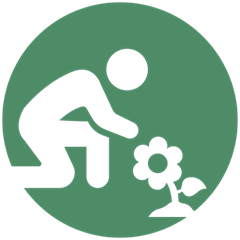EcoSchools U.S.
EcoSchools U.S. is a program run by the National Wildlife Federation that uses school-based action teams of students, administrators, educators, and community volunteers to drive environmental stewardship and education in schools.
Fairfax County Public Schools and the National Wildlife Federation have a formal Ignite partnership to engage students in hands-on environmental action through the EcoSchools program.
The EcoSchools U.S. program was overhauled in September 2023. You can learn more on the EcoSchools US website and through the overview below.
How does my school become an EcoSchool?
Starting in the 2023-24 school year, EcoSchools requires schools to register each year. Registration opens in early September and is quick and easy. You can register on the EcoSchools website.
My school is a registered EcoSchool. What do we do now?
Once you register, you can get started by following the EcoSchools framework. The steps in the framework are not necessarily linear - some are ongoing, some repeat, and others may be a one-time action.
 |
Work with People in Your Community Make lasting connections with people inside and outside of school, and share the stories connected to learning and action for the planet. |
 |
Form an Action Team Your school’s Eco-Action Team is a student-led team that guides the environmental stewardship efforts at your school. In addition to students, your team should include teachers, administrators, custodians, parents, volunteers, and other community members. Feel free to give your team a creative name! |
 |
Develop an Action Plan As a team, develop a plan for your environmental action this year. The EcoSchools Action Card Library has options, plus you can add an action of your own for each theme. |
 |
Take Action, Collect Data, Measure Impact, and Share Stories Explore community and nature-based solutions for your team's action plan, measure your school's impact, and share accessible, fact-based stories to raise awareness and promote collaboration. |
 |
Monitor and Evaluate Your Progress Collect data before and after taking action to evaluate how well the plan is working and keep the school community informed about the progress and results.
|
 |
Connect Your Actions to Curriculum The team’s nature and community-based actions will connect to what students are learning in classrooms. The Get2Green team can also help you make connections. |
 |
Celebrate and Create an EcoCode An EcoCode is your Action Team’s mission statement – a sort of logo for your Team’s green efforts. An EcoCode shows the school’s green priorities in a fun and creative way. |
Themes
Unlike the old EcoSchools program that focused on twelve environmental pathways schools could choose to address, the new platform centers on three themes: Climate Change, Wildlife and Biodiversity, and Healthy and Resilient Communities. Actions are organized by theme, although many actions support more than one theme.
Awards
Your school’s team earns points for each action card you complete. These points add up to determine your award level for the year. The points needed for each award level are listed below, and you can find additional information in the EcoSchools US Certification Rubric.
Bronze Award: 50 points
Silver Award: 65 points
Gold Award: 80 points
Green Flag: 100 points
Award certification follows an annual cycle. If your school team is planning to apply for a Green Flag, you will need to login to your account and complete the Green Flag Eligibility Questionnaire by the last Friday in January. You must select actions totaling at least 100 points for the Green Flag Eligibility Questionnaire to appear under the Our Plan tab.
The award certification submission window is open from the first Friday in April through the first Friday in June each year.
Benefits
The EcoSchools U.S. program benefits students, schools, communities, and the environment. EcoSchools improves student performance and success, helps students prepare for STEAM careers, contributes to financial savings through energy and water conservation, reduces waste and consumption, increases environmental awareness and stewardship, and boosts community involvement.
Learn more on the EcoSchools U.S. website and explore the EcoSchools School Resources page to find the certification guide, framework for K-5 and 6-12, themes, and action card library. The EcoSchools Certification FAQ has answers about the new program.


